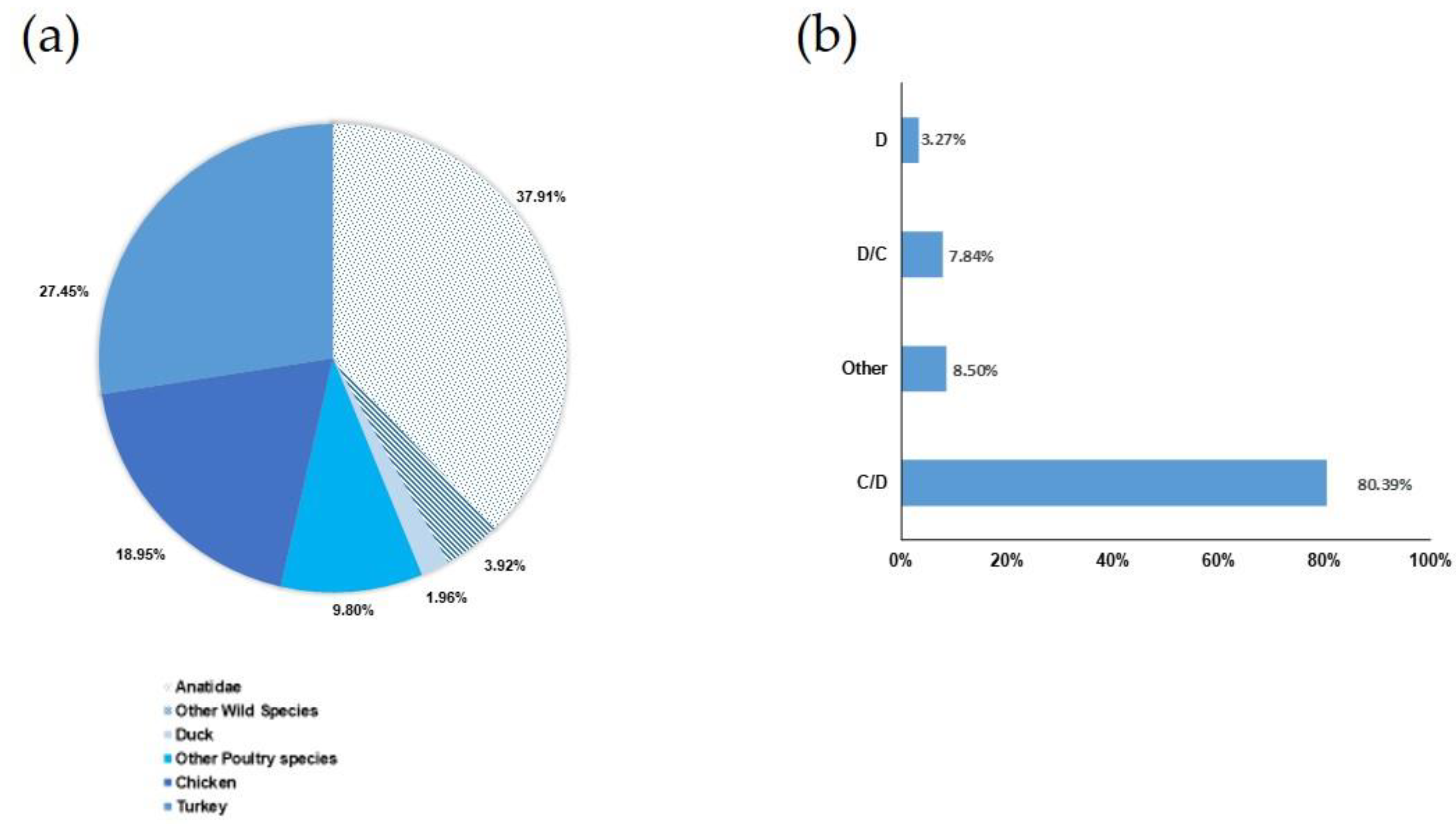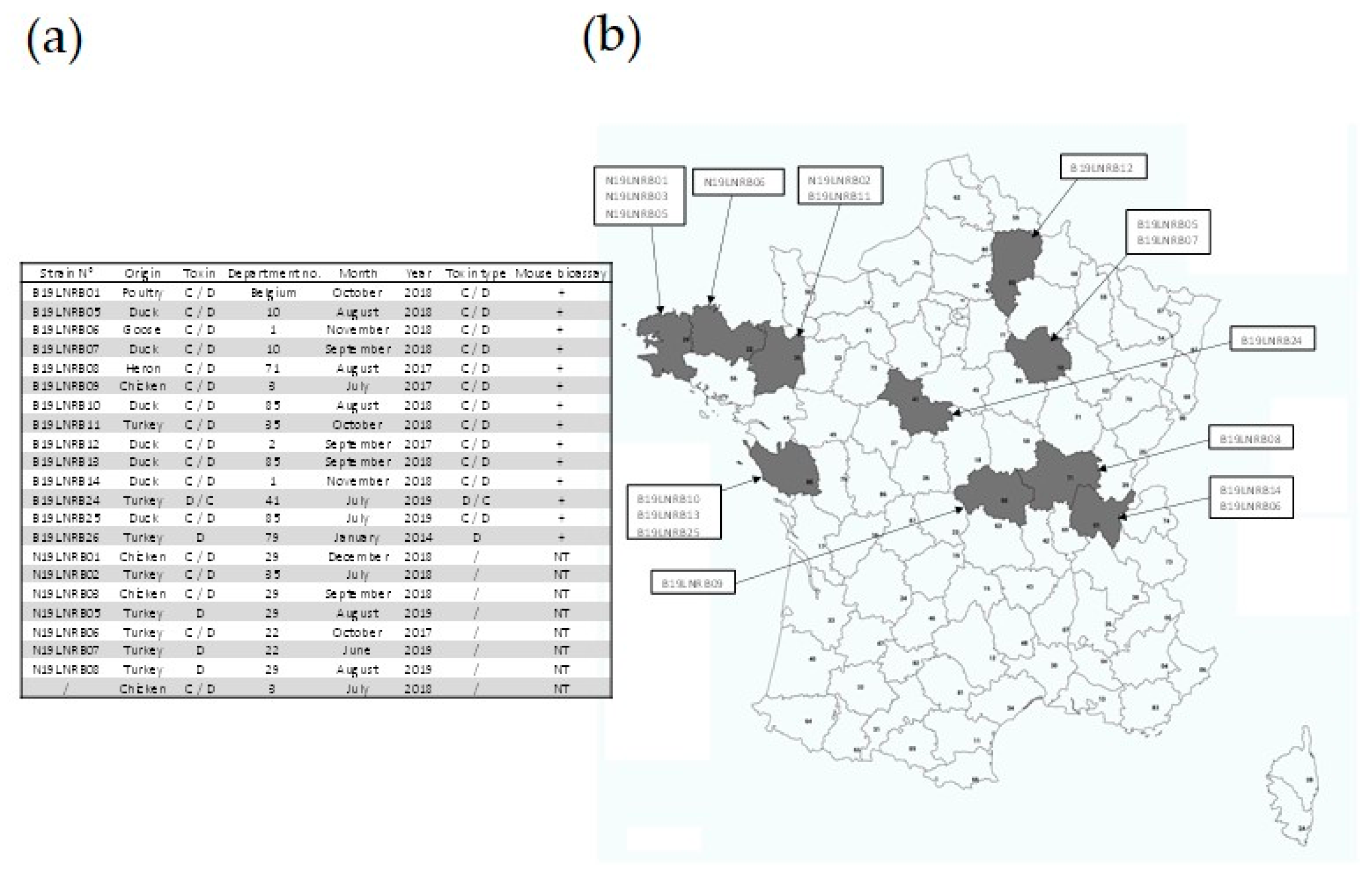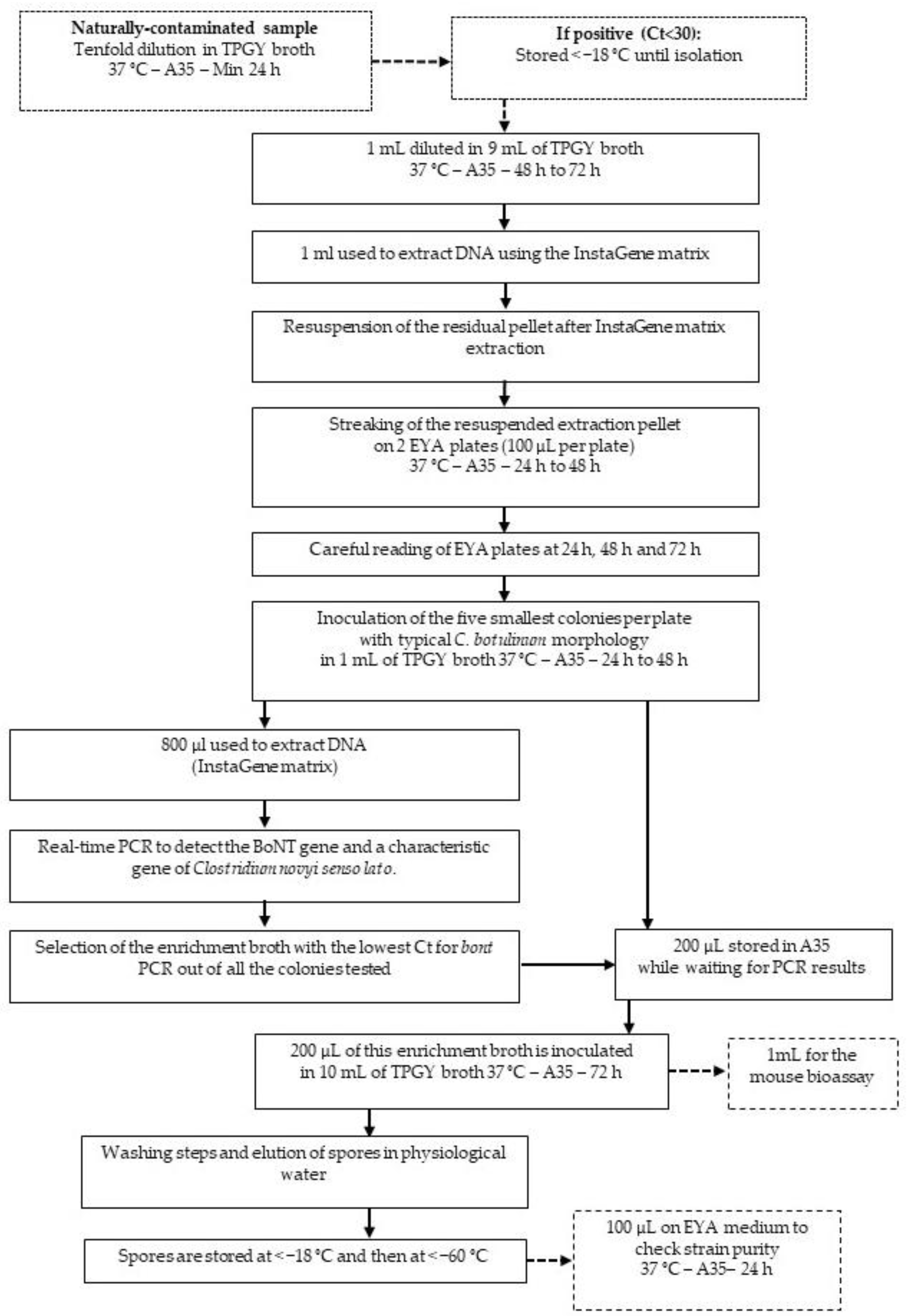Development of An Innovative and Quick Method for the Isolation of Clostridium botulinum Strains Involved in Avian Botulism Outbreaks
Abstract
1. Introduction
2. Results
2.1. Selection of Samples for Evaluating the Isolation Protocol
2.2. Evaluation of the Method Using Naturally Contaminated Samples
2.3. Confirmation of the Method Using Spiked Samples
3. Discussion
4. Conclusions
5. Materials and Methods
5.1. Samples
5.2. Confirmation of the Method Using Spiked Samples
5.3. InstaGene DNA Extraction
5.4. Real-Time PCR
5.5. Isolation on Egg Yolk Agar
5.6. Strain Storage
5.7. Detection of BoNT Production by Strains Following Isolation
Author Contributions
Funding
Acknowledgments
Conflicts of Interest
References
- Tehran, D.A.; Pirazzini, M. Novel Botulinum Neurotoxins: Exploring Underneath the Iceberg Tip. Toxins 2018, 10, 190. [Google Scholar] [CrossRef]
- Pirazzini, M.; Azarnia Tehran, D.; Zanetti, G.; Rossetto, O.; Montecucco, C. Hsp90 and Thioredoxin-Thioredoxin Reductase enable the catalytic activity of Clostridial neurotoxins inside nerve terminals. Toxicon 2018, 147, 32–37. [Google Scholar] [CrossRef]
- Lindstrom, M.; Korkeala, H. Laboratory diagnostics of botulism. Clin. Microbiol. Rev. 2006, 19, 298–314. [Google Scholar] [CrossRef]
- Zhang, S.; Masuyer, G.; Zhang, J.; Shen, Y.; Lundin, D.; Henriksson, L.; Miyashita, S.I.; Martinez-Carranza, M.; Dong, M.; Stenmark, P. Identification and characterization of a novel botulinum neurotoxin. Nat. Commun. 2017, 8, 14130. [Google Scholar] [CrossRef]
- Peck, M.W.; Smith, T.J.; Anniballi, F.; Austin, J.W.; Bano, L.; Bradshaw, M.; Cuervo, P.; Cheng, L.W.; Derman, Y.; Dorner, B.G.; et al. Historical Perspectives and Guidelines for Botulinum Neurotoxin Subtype Nomenclature. Toxins 2017, 9, 38. [Google Scholar] [CrossRef]
- Doxey, A.C.; Mansfield, M.J.; Montecucco, C. Discovery of novel bacterial toxins by genomics and computational biology. Toxicon 2018, 147, 2–12. [Google Scholar] [CrossRef]
- Mansfield, M.J.; Doxey, A.C. Genomic insights into the evolution and ecology of botulinum neurotoxins. Pathog. Dis. 2018, 76. [Google Scholar] [CrossRef]
- Le Marechal, C.; Woudstra, C.; Fach, P. Botulism. In Clostridial Diseases in Animals; Uzal, F.A., Songer, J.G., Prescott, J.F., Popoff, M.R., Eds.; John Wiley & Sons, Inc.: Ames, IA, USA, 2016; pp. 303–330. [Google Scholar]
- Skarin, H.; Tevell Åberg, A.; Woudstra, C.; Hansen, T.; Löfström, C.; Koene, M.; Bano, L.; Hedeland, M.; Anniballi, F.; De Medici, D.; et al. The workshop on animal botulism in Europe. Biosecur. Bioterror. 2013, 11, S183–S190. [Google Scholar] [CrossRef] [PubMed]
- Ventujol, A.; Decors, A.; Le Maréchal, C.; Toux, J.Y.; Allain, V.; Mazuet, C.; Bayon-Auboyer, M.-H.; Le Bouquin, S.; Souillard, R. Le botulisme aviaire en France: Etude des cas signalés dans la faune sauvage et dans les élevages par deux réseaux de surveillance entre 2000 et 2013. Epidémiologie et Santé Animale 2017, 72, 85–102. [Google Scholar]
- Notermans, S.; Dufrenne, J.; Oosterom, J. Persistence of Clostridium botulinum type B on a cattle farm after an outbreak of botulism. Appl. Environ. Microbiol. 1981, 41, 179–183. [Google Scholar] [CrossRef] [PubMed]
- Souillard, R.; Woudstra, C.; Le Marechal, C.; Dia, M.; Bayon-Auboyer, M.H.; Chemaly, M.; Fach, P.; Le Bouquin, S. Investigation of Clostridium botulinum in commercial poultry farms in France between 2011 and 2013. Avian Pathol. 2014, 43, 458–464. [Google Scholar] [CrossRef] [PubMed]
- Rocke, T.E. The global importance of avian botulism. In Waterbirds Around the World; G.C. Boere, C.A.G., Stroud, D.A., Eds.; The Stationery Office: Edinburgh, UK, 2006; pp. 422–426. [Google Scholar]
- Woudstra, C.; Skarin, H.; Anniballi, F.; Fenicia, L.; Bano, L.; Drigo, I.; Koene, M.; Bayon-Auboyer, M.H.; Buffereau, J.P.; De Medici, D.; et al. Neurotoxin gene profiling of Clostridium botulinum types C and D native to different countries within Europe. Appl. Environ. Microbiol. 2012, 78, 3120–3127. [Google Scholar] [CrossRef] [PubMed]
- Le Marechal, C.; Ballan, V.; Rouxel, S.; Bayon-Auboyer, M.H.; Baudouard, M.A.; Morvan, H.; Houard, E.; Poezevara, T.; Souillard, R.; Woudstra, C.; et al. Livers provide a reliable matrix for real-time PCR confirmation of avian botulism. Anaerobe 2016, 38, 7–13. [Google Scholar] [CrossRef] [PubMed]
- Bano, L.; Drigo, I.; Tonon, E.; Pascoletti, S.; Puiatti, C.; Anniballi, F.; Auricchio, B.; Lista, F.; Montecucco, C.; Agnoletti, F. Identification and characterization of Clostridium botulinum group III field strains by matrix-assisted laser desorption-ionization time-of-flight mass spectrometry (MALDI-TOF MS). Anaerobe 2017, 48, 126–134. [Google Scholar] [CrossRef]
- Takeda, M.; Tsukamoto, K.; Kohda, T.; Matsui, M.; Mukamoto, M.; Kozaki, S. Characterization of the neurotoxin produced by isolates associated with avian botulism. Avian Dis. 2005, 49, 376–381. [Google Scholar] [CrossRef]
- Popoff, M. Revue sur l’épidémiologie du botulisme bovin en France et analyse de sa relation avec les élevages de volailles. Revue Scientifique et Technique de l’Office international des Epizooties 1989, 8, 129–145. [Google Scholar] [CrossRef]
- Nakamura, K.; Kohda, T.; Shibata, Y.; Tsukamoto, K.; Arimitsu, H.; Hayashi, M.; Mukamoto, M.; Sasakawa, N.; Kozaki, S. Unique biological activity of botulinum D/C mosaic neurotoxin in murine species. Infect. Immun. 2012, 80, 2886–2893. [Google Scholar] [CrossRef]
- Bjornstad, K.; Tevell Aberg, A.; Kalb, S.R.; Wang, D.; Barr, J.R.; Bondesson, U.; Hedeland, M. Validation of the Endopep-MS method for qualitative detection of active botulinum neurotoxins in human and chicken serum. Anal. Bioanal. Chem. 2014, 406, 7149–7161. [Google Scholar] [CrossRef]
- Anniballi, F.; Auricchio, B.; Delibato, E.; Antonacci, M.; De Medici, D.; Fenicia, L. Multiplex real-time PCR SYBR Green for detection and typing of group III Clostridium botulinum. Vet. Microbiol. 2012, 154, 332–338. [Google Scholar] [CrossRef]
- Anniballi, F.; Auricchio, B.; Woudstra, C.; Fach, P.; Fiore, A.; Skarin, H.; Bano, L.; Segerman, B.; Knutsson, R.; De Medici, D. Multiplex real-time PCR for detecting and typing Clostridium botulinum group III organisms and their mosaic variants. Biosecur. Bioterrori. 2013, 11, S207–S214. [Google Scholar] [CrossRef]
- Hansbauer, E.M.; Skiba, M.; Endermann, T.; Weisemann, J.; Stern, D.; Dorner, M.B.; Finkenwirth, F.; Wolf, J.; Luginbuhl, W.; Messelhausser, U.; et al. Detection, differentiation, and identification of botulinum neurotoxin serotypes C, CD, D, and DC by highly specific immunoassays and mass spectrometry. Analyst 2016, 141, 5281–5297. [Google Scholar] [CrossRef] [PubMed]
- Le Marechal, C.; Rouxel, S.; Ballan, V.; Houard, E.; Poezevara, T.; Bayon-Auboyer, M.H.; Souillard, R.; Morvan, H.; Baudouard, M.A.; Woudstra, C.; et al. Development and Validation of a New Reliable Method for the Diagnosis of Avian Botulism. PLoS ONE 2017, 12, e0169640. [Google Scholar] [CrossRef] [PubMed][Green Version]
- Anniballi, F.; Fillo, S.; Giordani, F.; Auricchio, B.; Tehran, D.A.; di Stefano, E.; Mandarino, G.; De Medici, D.; Lista, F. Multiple-locus variable number of tandem repeat analysis as a tool for molecular epidemiology of botulism: The Italian experience. Infect. Genet. Evol. 2016, 46, 28–32. [Google Scholar] [CrossRef] [PubMed]
- Giordani, F.; Fillo, S.; Anselmo, A.; Palozzi, A.M.; Fortunato, A.; Gentile, B.; Azarnia Tehran, D.; Ciammaruconi, A.; Spagnolo, F.; Pittiglio, V.; et al. Genomic characterization of Italian Clostridium botulinum group I. strains. Infect. Genet. Evol. 2015, 36, 62–71. [Google Scholar] [CrossRef] [PubMed]
- Skarin, H.; Lindberg, A.; Blomqvist, G.; Aspan, A.; Baverud, V. Molecular characterization and comparison of Clostridium botulinum type C avian strains. Avian Pathol. 2010, 39, 511–518. [Google Scholar] [CrossRef]
- Sakaguchi, Y.; Hayashi, T.; Kurokawa, K.; Nakayama, K.; Oshima, K.; Fujinaga, Y.; Ohnishi, M.; Ohtsubo, E.; Hattori, M.; Oguma, K. The genome sequence of Clostridium botulinum type C neurotoxin-converting phage and the molecular mechanisms of unstable lysogeny. Proc. Natl. Acad. Sci. USA 2005, 102, 17472–17477. [Google Scholar] [CrossRef]
- Skarin, H.; Hafström, T.; Westerberg, J.; Segerman, B. Clostridium botulinum group III: A group with dual identity shaped by plasmids, phages and mobile elements. BMC Genom. 2011, 12. [Google Scholar] [CrossRef]
- Franciosa, G.; Fenicia, L.; Caldiani, C.; Aureli, P. PCR for detection of Clostridium botulinum type C in avian and environmental samples. J. Clin. Microbiol. 1996, 34, 882–885. [Google Scholar] [CrossRef]
- Eklund, M.W.; Poysky, F.T.; Meyers, J.A.; Pelroy, G.A. Interspecies conversion of Clostridium botulinum type C to Clostridium novyi type A by bacteriophage. Science 1974, 186, 456–458. [Google Scholar] [CrossRef]
- Bano, L.; Drigo, I.; Tonon, E.; Berto, G.; Tavella, A.; Woudstra, C.; Capello, K.; Agnoletti, F. Evidence for a natural humoral response in dairy cattle affected by persistent botulism sustained by non-chimeric type C strains. Anaerobe 2015. [Google Scholar] [CrossRef]
- Oguma, K.; Yamaguchi, T.; Sudou, K.; Yokosawa, N.; Fujikawa, Y. Biochemical classification of Clostridium botulinum type C and D strains and their nontoxigenic derivatives. Appl. Environ. Microbiol. 1986, 51, 256–260. [Google Scholar] [CrossRef] [PubMed]
- Skarin, H.; Segerman, B. Plasmidome interchange between Clostridium botulinum, Clostridium novyi and Clostridium haemolyticum converts strains of independent lineages into distinctly different pathogens. PLoS ONE 2014, 9, e107777. [Google Scholar] [CrossRef] [PubMed]
- Anza, I.; Skarin, H.; Vidal, D.; Lindberg, A.; Baverud, V.; Mateo, R. The same clade of Clostridium botulinum strains is causing avian botulism in southern and northern Europe. Anaerobe 2014, 26, 20–23. [Google Scholar] [CrossRef] [PubMed]
- Brauge, T.; Faille, C.; Inglebert, G.; Dubois, T.; Morieux, P.; Slomianny, C.; Midelet-Bourdin, G. Comparative evaluation of DNA extraction methods for amplification by qPCR of superficial vs intracellular DNA from Bacillus spores. Int. J. Food Microbiol. 2018, 266, 289–294. [Google Scholar] [CrossRef] [PubMed]
- Segner, W.P.; Schmidt, C.F.; Boltz, J.K. Minimal growth temperature, sodium chloride tolerance, pH sensitivity, and toxin production of marine and terrestrial strains of Clostridium botulinum type C. Appl. Microbiol. 1971, 22, 1025–1029. [Google Scholar] [CrossRef] [PubMed]
- Woudstra, C.; Le Marechal, C.; Souillard, R.; Anniballi, F.; Auricchio, B.; Bano, L.; Bayon-Auboyer, M.H.; Koene, M.; Mermoud, I.; Brito, R.B.; et al. Investigation of Clostridium botulinum group III’s mobilome content. Anaerobe 2017, 49, 71–77. [Google Scholar] [CrossRef]
- Jang, I.; Kang, M.S.; Kim, H.R.; Oh, J.Y.; Lee, J.I.; Lee, H.S.; Kwon, Y.K. Occurrence of avian botulism in Korea during the period from June to September 2012. Avian Dis. 2014, 58, 666–669. [Google Scholar] [CrossRef]
- Popp, C.; Hauck, R.; Gad, W.; Hafez, H.M. Type C botulism in a commercial Turkey farm: A case report. Avian Dis. 2012, 56, 760–763. [Google Scholar] [CrossRef]
- Lindberg, A.; Skarin, H.; Knutsson, R.; Blomqvist, G.; Baverud, V. Real-time PCR for Clostridium botulinum type C neurotoxin (BoNTC) gene, also covering a chimeric C/D sequence-Application on outbreaks of botulism in poultry. Vet. Microbiol. 2010, 146, 118–123. [Google Scholar] [CrossRef]
- Woudstra, C.; LeMarechal, C.; Souillard, R.; Bayon-Auboyer, M.H.; Anniballi, F.; Auricchio, B.; De Medici, D.; Bano, L.; Koene, M.; Sansonetti, M.H.; et al. Molecular gene profiling of Clostridium botulinum group III and their detection in naturally contaminated samples originating from various European countries. Appl. Environ. Microbiol. 2015. [Google Scholar] [CrossRef]




| Spore Reference | BoNT Type | C. novyi sensu lato Group Detection after Isolation According to Figure 3 | ntnh Detection after Isolation According to Figure 3 |
|---|---|---|---|
| CIP 109 785 | C | + | + |
| CIP 105 256 | D | + | + |
| B17LNRB4 | C/D | + | + |
| B19LNRB3 | D/C | + | + |
© 2020 by the authors. Licensee MDPI, Basel, Switzerland. This article is an open access article distributed under the terms and conditions of the Creative Commons Attribution (CC BY) license (http://creativecommons.org/licenses/by/4.0/).
Share and Cite
Le Gratiet, T.; Poezevara, T.; Rouxel, S.; Houard, E.; Mazuet, C.; Chemaly, M.; Le Maréchal, C. Development of An Innovative and Quick Method for the Isolation of Clostridium botulinum Strains Involved in Avian Botulism Outbreaks. Toxins 2020, 12, 42. https://doi.org/10.3390/toxins12010042
Le Gratiet T, Poezevara T, Rouxel S, Houard E, Mazuet C, Chemaly M, Le Maréchal C. Development of An Innovative and Quick Method for the Isolation of Clostridium botulinum Strains Involved in Avian Botulism Outbreaks. Toxins. 2020; 12(1):42. https://doi.org/10.3390/toxins12010042
Chicago/Turabian StyleLe Gratiet, Thibault, Typhaine Poezevara, Sandra Rouxel, Emmanuelle Houard, Christelle Mazuet, Marianne Chemaly, and Caroline Le Maréchal. 2020. "Development of An Innovative and Quick Method for the Isolation of Clostridium botulinum Strains Involved in Avian Botulism Outbreaks" Toxins 12, no. 1: 42. https://doi.org/10.3390/toxins12010042
APA StyleLe Gratiet, T., Poezevara, T., Rouxel, S., Houard, E., Mazuet, C., Chemaly, M., & Le Maréchal, C. (2020). Development of An Innovative and Quick Method for the Isolation of Clostridium botulinum Strains Involved in Avian Botulism Outbreaks. Toxins, 12(1), 42. https://doi.org/10.3390/toxins12010042





